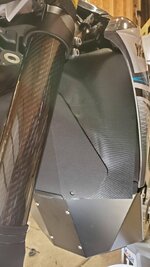M
MountainRider05
Well-known member
Hmm kinda a bummer hearing about temps. What about slightly closing down the bypass valve?
Follow along with the video below to see how to install our site as a web app on your home screen.
Note: This feature may not be available in some browsers.
Hmm kinda a bummer hearing about temps. What about slightly closing down the bypass valve?
I dont think you can close up the bypass valve, as it would cause the water pump to struggle. I feel like you need proper flow.
Reducing, or even closing, the bypass circuit is an option. Deadheading will not hurt this type of waterpump. But most thermostats have bleed holes anyway so even if the bypass is completely closed off, you are not truly deadheaded. Somewhat a concern is thermal shock, meaning your thermostat opens and 100% icy coolant hits your hot motor, but the bleed hole is already caring for that to an extent. And we are already blasting our hot engines with snow. And if the coolant coming out of the head is hot, the thermostat opens and coolant circulates freely and cools your engine.
For heated bars, you typically wouldn't completely close off the bypass circuit anyway. For the heat exchanger, you might. Still not much of a concern (FAQs regarding deadheading on the C3 website explain this), but if you are, Selkirk sells valves that you could plumb to bypass the heat exchanger, as needed, with a valve so you can tailor how much is going to the heat exchanger and how much is straight bypass (and/or handlebars).
Reducing, or even closing, the bypass circuit is an option. Deadheading will not hurt this type of waterpump. But most thermostats have bleed holes anyway so even if the bypass is completely closed off, you are not truly deadheaded. Somewhat a concern is thermal shock, meaning your thermostat opens and 100% icy coolant hits your hot motor, but the bleed hole is already caring for that to an extent. And we are already blasting our hot engines with snow. And if the coolant coming out of the head is hot, the thermostat opens and coolant circulates freely and cools your engine.
For heated bars, you typically wouldn't completely close off the bypass circuit anyway. For the heat exchanger, you might. Still not much of a concern (FAQs regarding deadheading on the C3 website explain this), but if you are still concerned, Selkirk sells valves that you could plumb to bypass the heat exchanger, as needed, with a valve so you can tailor how much is going to the heat exchanger and how much is straight bypass (and/or handlebars).
Yamahas run cool, KTM/husky can run hot. We went to slightly smaller vents on the Yamahas this year, will probably go even smaller. We are working on a different style of Yamaha radiator guard/protection/heat shield to replace the ice prone stock plastic. Blocking off the upper 1/3 of rads should increase temps and help ice buildup. Spacing the heat exchanger 1/8 off front of shield will help keep heat in. Seal the gap between lower side panels and frame to keep snow out. Easier to make it warmer than colder.
As for KTM's running cold with Engine Armor, not in our experience. Stuck open thermostat? If running cool, slow airflow, block left side radiator to get temps up, cover left side vents if needed. Let the heat exchanger, thermostat, and cooling system control the temps.
If running hot, run a fan or ride faster! Airflow makes a big difference, slow going will raise temps. Every bike, rider, and thermostat/bar combo runs different. Block or increase airflow to adjust, keep the heat exchanger working.
There is very little coolant in these engines, not much capacity for rapid condition changes.
We will have more block off options as soon as we can get caught up on orders.
Thanks everyone!
Thanks everyone!
What Bike are you riding?I had my maiden voyage with the selkirk yesterday. Outside temps were around -3c or 27f. After reading this thread I decided to float my heatsink and put some small washers between the skidplate and the heatsink. We had 3ft of blower pow, so it was the perfect day to test with me plowing snow wherever I went, and yet warm temps on the trail up.
All I can says is... WOW it was amazing! It is everything I wanted it to be. Here are the points of interest of the ride:
1. Trail up was groomed and the bike was getting a bit hot, pushing 200+F and forcing me to hop off the trail into the powder wherever possible in order to bring temps down.
2. Once I got to the top in the powder the temps were PERFECT all day. Always 150-170 in the deep powder.
3. An added benefit I noticed is that the engine retains heat a lot better when you stop for a while. Usually it gets quite cold when you stop to dig someone out or have a snack. I would fire up the motor after a wait and be greeted with temps around 120-130 still.
4. Since the only time it was getting hot was on the trail, I wanted to test taking the front rad blocker off and going in powder to see what would happen. To my surprise, the temps were not affected and still hovered between 150 and 170 in the deep stuff.
5. Trail down is always easier on the motor and wont be as hot, but going down the temps were a perfect 170 without that front cover on.
I think I am going to leave that cover off on nice days and experiment with putting it on for those cold days. First ride though, I am thrilled!
What Bike are you riding?
Ok thanks for the report2014 450SXF Factory edition with a 520 big bore kit. Pictures higher up in this thread.





